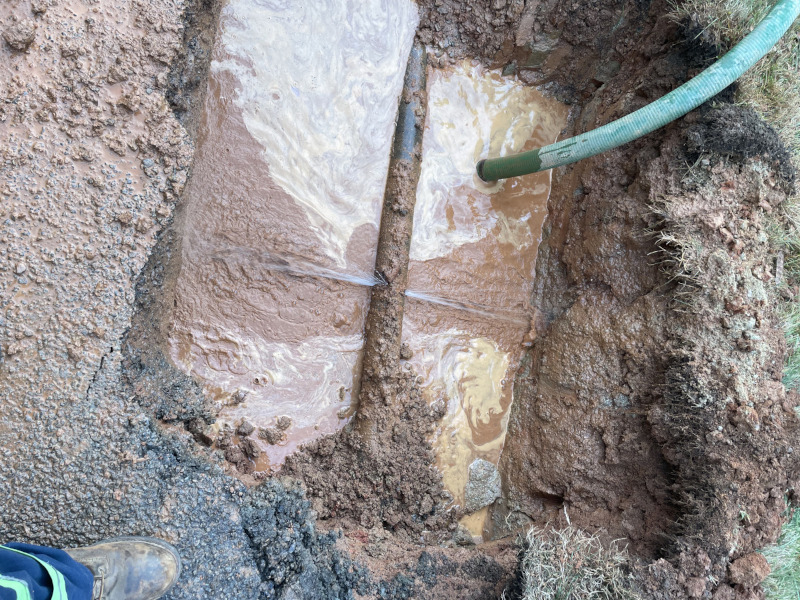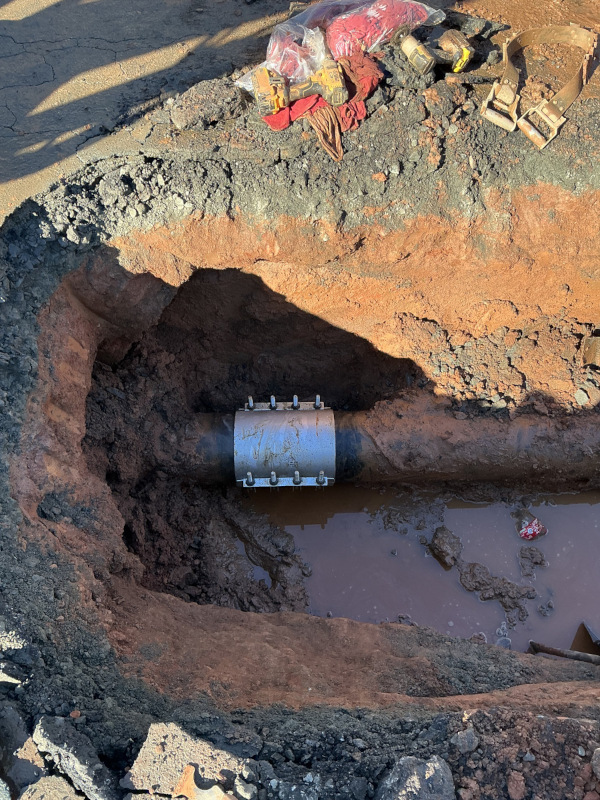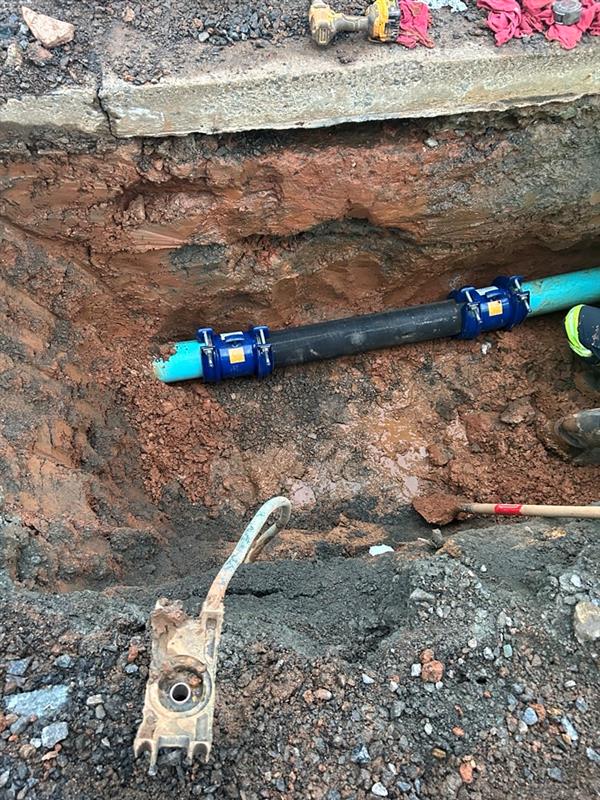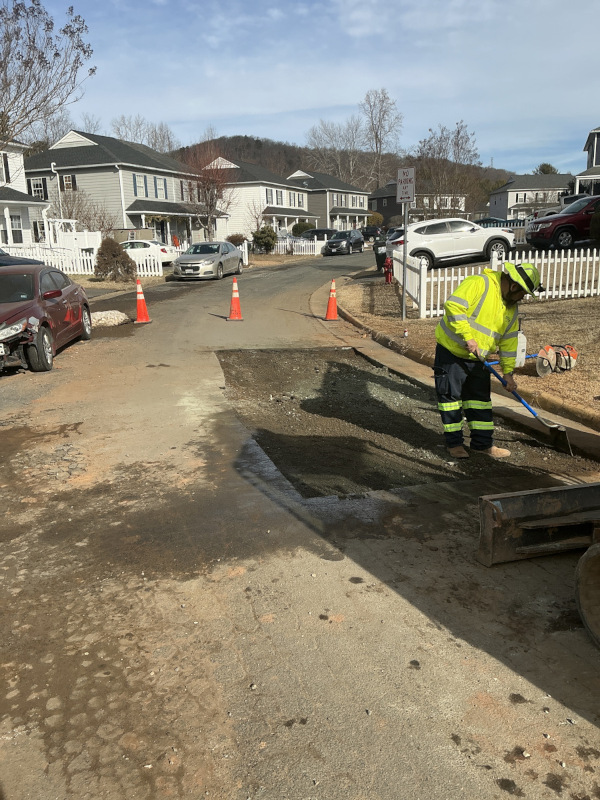Behind the Scenes of a Water Main Repair

How ACSA Restores Service and Keeps Water Flowing
Moving water from Albemarle County’s natural resources to your tap requires a complex tapestry of infrastructure. On its path from river to treatment plant to kitchen sink, your water takes a winding journey through pipes, pumps, filters and more — all so you can enjoy it in your home with the pull of a faucet.
But sometimes there can be a break in that chain, which may interrupt service. One type of interruption is the dreaded “water main break.” It’s an infrequent but disruptive event that can cause widespread water outages for customers in our service area.
And while the Albemarle County Service Authority’s (ACSA’s) amazing team is well equipped to handle breaks, we also believe in educating our community about the complexities of water utility service.
What is a water main?
A water main is a large pipe that transports clean water from our treatment plants to the homes and businesses ACSA serves. Many mains run underneath highways and neighborhood streets, as well as through wooded and hilly areas. In total, ACSA maintains approximately 377 miles of main lines to move clean, treated water to the more than 23,000 homes and facilities within our network.
What is a water main break?
A water main break occurs when one of these pipes cracks, bursts or begins leaking — often causing water pressure to drop or service to be interrupted for customers in the area.
What causes water main breaks?
While buried underground and made of highly durable material, water mains can sometimes leak or even break due to normal wear and tear. This can also happen as the result of an accident such as a digging mishap — remember to always call Miss Utility at 811 before you dig!
How does ACSA repair a broken water main?
The sheer volume of water traveling through a water main makes even a small leak a big deal. Because of that, repairing a water main break is a time-consuming, step-by-step process that requires collaboration between multiple crew members and specialists. Repairs may take hours or even days depending on the location and severity of the leak.
The good news is that ACSA is prepared to repair water main breaks as quickly as possible. Our crews are trained to locate and repair breaks efficiently and to do so with minimal property damage and water loss. After all, every minute a main is shut down is a minute that ACSA customers go without access to clean water.
The bad news is that main repairs are complex and must be done in stages. If you’ve seen crews standing around during a water outage, what they’re actually doing is waiting for the current stage of the repair to be completed by other specialists so they can immediately jump in and begin the next phase.

What are ACSA’s steps to fixing a broken water main?
In the event ACSA learns of a main break, our team has to first track down where the break has actually occurred. With hundreds of miles of pipe throughout Albemarle County — including through tough terrain — that’s not an easy or quick process. It requires a thorough understanding of Albemarle County’s water infrastructure, referencing numerous maps and schematics, and consideration of the best access point in relation to surrounding property (i.e. busy highways and neighborhoods).
Once our crew finds the break, they must identify and mark other underground utilities. This important step may take several hours, but it prevents further damage to crucial infrastructure, such as gas and sewer. Depending upon the severity of the break, the water main may need to be isolated to prevent further damage to the area. During this time, the rest of the crew will gather necessary equipment and stand by so they can get to work as soon as they receive the all-clear.
When the leak area has been located and the site prepped, our team begins “excavation” — or, more simply, digging. Water mains are typically installed 3-4 feet in the ground, and depending on the size of the leak, getting to the main can become quite messy! It may take more time to find the location of the leak, especially if the crew determines the main valve must be shut off to prevent further property damage.

When our crew locates the broken portion of the water main, repairs begin. This includes fixing or replacing the damaged section of the pipe, re-pressurizing under system pressure and completing a visual inspection to ensure that the repair holds. Once everything is secured, our crew will slowly turn the water back on, opening a fire hydrant to release excess air and discolored water from the system. This last step ensures that the water that eventually reaches your tap is of the quality and clarity standards you expect from ACSA.
Is the repair done once water flow has been restored?
Not quite! Even when the main has been repaired and water flow has been restored, our crews need to backfill the excavation site and restore the area to its original condition. The crew leader must test hydrant water samples to ensure chlorine levels are within range and other quality standards are met. The crew also needs to clean up the work area, including removal of debris and equipment.

Altogether, this entire process can last multiple days, even when addressed by a large crew. Trust us—we’re just as eager to fix the issue as our customers! Repairs like these cost time and money, interrupt the quality water service we pride ourselves on, and can create quite a mess.
Luckily for ACSA customers, we regularly assess and update our systems to keep main breaks and other costly infrastructure-related issues to a minimum. Accidents happen, and water is a notoriously relentless source of wear and tear, but our customers should take comfort in knowing that we take a proactive approach through Capital Improvement Plan projects. These projects replace aging infrastructure to reduce the chances of main failures and other issues.
We hope this blog has helped shine some light on one of the many ways we work to keep your water safe, clean and flowing. The next time you see an ACSA crew out in the field — whether they’re digging or standing by for the next phase of a repair — know that they’re dedicated to keeping your home or business running smoothly.
Please join us on November 20, 2025 at 9:00AM for our monthly Board of Directors…
Serving as ACSA’s Procurement/Financial Specialist, Tonya “raises the bar for ACSA’s standards,” is “always at…
Whether you’re a homeowner or landlord, follow these five straightforward tips to keep your pipes…
Allen’s service is described as “best in class” in the way he supports his coworkers,…
Due to unforeseen circumstances, the ACSA Board Meeting scheduled to be held on Thursday, October…
Check out the ACSA Fall 2025 newsletter. Our most recent newsletter includes:
